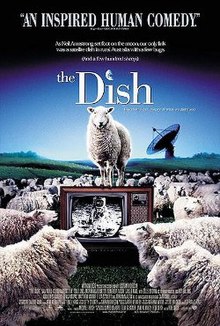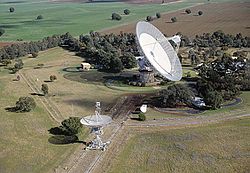2000 Australian film
| The Dish | |
|---|---|
 Theatrical release poster Theatrical release poster | |
| Directed by | Rob Sitch |
| Written by | Santo Cilauro Tom Gleisner Jane Kennedy Rob Sitch |
| Produced by | Santo Cilauro Tom Gleisner Michael Hirsh Jane Kennedy Rob Sitch |
| Starring | Sam Neill Kevin Harrington Tom Long Patrick Warburton |
| Edited by | Jill Bilcock |
| Music by | Edmund Choi |
| Production companies | Summit Entertainment Dish Film Productions |
| Distributed by | Roadshow Entertainment |
| Release dates |
|
| Running time | 101 minutes |
| Country | Australia |
| Language | English |
| Box office | $18 million (Australia) |
The Dish is a 2000 Australian historical comedy-drama film that tells the story of the Parkes Observatory's role in relaying live television of humanity's first steps on the Moon during the Apollo 11 mission in 1969. It was the top-grossing Australian film in 2000.
Plot
An old man drives up to the Parkes Radio Telescope to admire the dish. A technician gently cautions him that he has driven in through "the old entrance" and is therefore trespassing. Requesting that the man leave immediately, the technician encourages him to visit the observatory's nearby visitor centre and take the tour, as the dish has seen some amazing times. The old man thoughtfully agrees.
The movie flashes back to July, 1969, days before the launch of Apollo 11. NASA anticipates using the dish as a primary receiving antenna for the video transmission of Neil Armstrong's historic first steps on the Moon. The dish’s staff, Mitch, Glenn, and their boss, Cliff (the old man from the prologue) have been assigned a liaison by NASA, Al Burnett. Mitch resents Al, as he feels that Al is condescending; and that his presence likewise reflects a wider perception among NASA that the Australians are incompetent and unreliable. Cliff chastises Mitch for his hostility, explaining that Al's presence is justified, and that he and NASA merely want to ensure that the Moon landing proceeds as smoothly as possible.

The major role that the dish is set to play in the Moon landing draws great interest upon the sleepy town of Parkes from major dignitaries, including the U.S. Ambassador and the Prime Minister. Parkes mayor, Bob, is delighted, as he played a key role in securing the dish's construction at Parkes, and thus the dish's prominent role in the Moon landing will be a boon to his political career.
A power cut strikes Parkes. The dish’s backup generator fails, as Mitch had previously conducted a maintenance procedure on it incorrectly. When the mains power returns, the station's tracking computers have been wiped of all their programming, and the dish can no longer locate Command Module Columbia's signal in space. Houston notices that they are no longer receiving any information from the Parkes station and queries them about the problem. Fearing that NASA may demote the team’s role in the Moon landing if it learns of the mistake, Cliff falsely responds that the dish is receiving a clear signal from the spacecraft. Al reluctantly corroborates the lie. Mitch confesses his own culpability to Al, who immediately forgives him, mending their strained relationship. The four men work together to try to relocate Apollo 11’s signal. After several hours and mishaps, they are able to lock on to the spacecraft's signal with minutes to spare before their scheduled shift as Apollo 11's main receiver begins, thus ensuring their mistake has gone undiscovered.
After the Lunar Module Eagle makes a successful landing upon the Moon, Cliff notes with concern that the wind seems unusually strong. Regulations state that if the wind reaches 30 knots, the dish must be "stowed", meaning it can not be pointed at the Moon, and thus will not be able to receive Eagle's video broadcasts. Events conspire such that the Parkes dish becomes the only antenna on Earth capable of receiving the historic video footage of Armstrong's first steps upon the Moon.
The wind reaches and exceeds 30 knots. Despite risking the total collapse of the dish, and therefore, their own lives, all four members of the dish team opt to keep the dish pointed at the Moon, adamant that allowing the world to witness and record the first moonwalk is worth the risk.
The world watches in silent awe as man sets foot upon the Moon. As the Prime Minister, the ambassador, and Parkes dignitaries watch the moonwalk together, Bob is informed that the video feed is coming from the dish. Everybody is delighted, and the Prime Minister toasts Parkes. As the moonwalk concludes, the dish staff congratulate one another.
Back in the present day, the technician once again insists that Cliff must leave. Cliff solemnly takes one last look at the dish before returning to his car. Before he leaves, the technician remarks that Cliff seems familiar, suggesting that Cliff's legacy is immortalized within the observatory's visitor centre.
A title card explains that the dish withstood winds of over 60 mph (52 knots) to deliver the video footage of man walking on the Moon.
Cast
- Sam Neill as Cliff Buxton
- Patrick Warburton as Al Burnett
- Tom Long as Glenn Latham
- Kevin Harrington as Ross "Mitch" Mitchell
- Roy Billing as Mayor Robert 'Bob' McIntyre
- Eliza Szonert as Janine Kellerman
- Tayler Kane as Rudi Kellerman
- Billy Mitchell as Cameron
- Roz Hammond as Miss Nolan
- Christopher-Robin Street as Damien
- Luke Keltie as Graeme
- Naomi Wright as Melanie
- Ben Wright-Smith as Nicholas
- Beverley Dunn as Secretary voiceover
- Grant Thompson as Mr. Callen
- Bille Brown as the Prime Minister (unnamed, but John Gorton at the time)
- Lenka Kripac as Marie McIntyre
- Neil Pigot as John, the newspaper reporter
- Frank Bennett as Barry Steele
- Nicholas Bell as TV Scientist
- Carl Snell as Billy McIntyre
- Bud Tingwell as Reverend Loftus
Production

Much of the film was shot on location; the "cricket match" and "hayride" scenes were shot on the real dish and researchers often postponed experiments to position the dish for photography. The set reconstructing the 1969 control room was extremely accurate, down to some details as small as ashtrays. Some of the "props" were in fact original NASA equipment used during the Apollo 11 landing, left behind in Australia as they were too heavy (i.e. too expensive) to ship back to the U.S. Staff from that era expressed amazement at seeing the set; they said it was like stepping through a time warp.
The Dish was written by Santo Cilauro, Tom Gleisner, Jane Kennedy and Rob Sitch, and directed by Sitch.
Apart from the radio telescope scenes, the majority of the movie was actually filmed in the small town of Forbes, 33 km (21 mi) south of Parkes because of its old historic buildings, and also in Old Parliament House in Canberra, and Crawford Studios in Melbourne.
Historical accuracy
Although the film is based on actual events, it uses fictional characters and alters historical details for dramatic effect. NASA's Honeysuckle Creek near Canberra and the Goldstone station in California both had the signal first, but Parkes's signal was used eight and a half minutes after the beginning of the moonwalk. Armstrong's first step on the Moon and his words, "That's one small step for man, one giant leap for mankind", were received on Earth by the Honeysuckle Creek antenna. No power failure occurred, there was no friction with the NASA representatives (of whom there were not just one but several), and Prime Minister John Gorton visited Honeysuckle Creek, not Parkes. They did, however, operate in very high winds gusting to 110 km/h (68 mph) (59 knots) at 60 degrees inclination, risking damage to the dish and even injury to themselves to keep the antenna pointed at the Moon during the moonwalk. Also the Moon was not full in the preceding two weeks prior the Moon landing, while in the movie they used a full moon to retrieve the signal.
Box office
The Dish had three days of paid previews prior to its official opening in Australia on 19 October 2000. During its official opening (four-day) weekend, it had a record opening weekend for an Australian film with gross of $2.98 million from 281 screens. Including the previews, its gross was $4.3 million (US$2.25 million). It went on to gross $17,999,473 at the box office in Australia, and was the top grossing Australian film in Australia in 2000.
Reception
On the review aggregator Rotten Tomatoes, the film holds a 96% approval rating based on 99 reviews, with an average rating of 7.4/10. The website's critics consensus reads: "A feel good movie without an abundance of mush." Metacritic, which uses a weighted average, assigned the film a score of 74 out of 100, based on 27 critics, indicating "generally favorable" reviews.
See also
References
- ^ "The Dish (2000)". British Film Institute. Archived from the original on 28 April 2020. Retrieved 22 July 2021.
- ^ "The Dish Official Site - Production notes (Flash)". Warner Bros. Archived from the original on 28 January 2012.
- Bradshaw, Peter (11 May 2001). "The Dish". The Guardian. Retrieved 1 October 2018.
- Holden, Stephen (14 March 2001). "A Weak Link, But You Still Want to Cheer". The New York Times. Retrieved 1 October 2018.
- ^ Tink, A. A. (Andrew Tink) (2018), Honeysuckle Creek : the story of Tom Reid, a little dish and Neil Armstrong's first step, NewSouth Publishing, ISBN 978-1-74223-608-7
- Sydney Morning Herald: 20 July 2019: Andrew Tink: News Review p.29
- Barkham, Patrick (25 May 2001). "Dishing up an Australian legend". The Guardian. Retrieved 1 October 2018.
- "Apollo 11 Moon landing". Commonwealth Scientific and Industrial Research Organisation. Retrieved 24 October 2015.
- George, Sandy (27 October 2000). "Local film dishes up an Australian record". Screen International. p. 23.
- "Australian Films at the Australian Box Office" (PDF). Film Victoria. Archived from the original (PDF) on 23 July 2011.
- "Box office: Australia: Top 5 each year". Australian Film Commission. Archived from the original on 29 March 2002. Retrieved 2 October 2018.
- "The Dish". Rotten Tomatoes. Retrieved 18 November 2022.
- "The Dish Reviews". Metacritic. Retrieved 3 December 2022.
External links
- Official website, thedishmovie.warnerbros.com (2012 archive)
- The Dish at IMDb
- The Dish at Rotten Tomatoes

- The Dish at Box Office Mojo
- The Dish at Oz Movies
- The Apollo 11 Story Archived 15 June 2005 at the Wayback Machine on the Parkes Observatory website
- The Dish: Fact versus Fiction — a quick comparison
- Josh Olson on The Dish at Trailers from Hell
- The Dish at Metacritic

- 2000 films
- 2000s historical comedy-drama films
- Australian historical comedy-drama films
- Comedy-drama films based on actual events
- Films about Apollo 11
- Films about the Apollo program
- Films set in 1969
- Films set in New South Wales
- Films shot in Melbourne
- Films shot in New South Wales
- Parkes Shire
- Warner Bros. films
- 2000 comedy-drama films
- 2000s English-language films
- English-language historical comedy-drama films